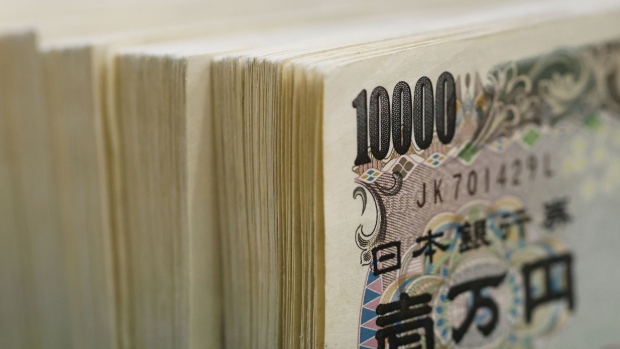Dec 19, 2022
Yen Jumps, Dollar Sinks After BOJ Surprises With Policy Tweak
, Bloomberg News

(Bloomberg) -- The Bank of Japan’s unexpected hawkish shift sent shock waves through global markets as the developed world’s last holdout for rock-bottom interest rates inches toward policy normalization.
Japanese government bonds and Treasuries both slumped, while the yen surged after the BOJ raised its cap on benchmark 10-year yields to around 0.5% from 0.25%, surprising every economist surveyed by Bloomberg. The fallout touched everything from US stock-index futures to the Australian dollar and gold.
The turbulence is unlikely to end on Tuesday. Japan is the world’s largest creditor, and tightening domestic financial conditions may result in a wave of capital returning home. That threatens to push down asset prices and boost global borrowing costs at a time the economic outlook is deteriorating.
“It’s important not to underestimate the impact this could have, because tighter BoJ policy would remove one of the last global anchors that’s helped to keep borrowing costs at low levels more broadly,” Deutsche Bank AG’s global head of macro research Jim Reid wrote in a note to clients.
Investors are expected to exit bonds in the US, Australia and France, and developed-market equities also likely to decline, according to UBS Group AG. The Swiss bank’s asset management arm, as well as Schroders Plc and BlueBay Asset Management, are among those who stand to benefit from the BoJ’s decision.
The yield on French 10-year bonds rose 9 basis points to 2.81%, the most among core markets in the region. Equivalent German securities fell a fifth straight day, putting the notes on track for their longest losing streak since early September.
BlueBay, UBS Asset Winners From Bets Bank of Japan Would Crack
“This was bound to happen with inflation rising in Japan, it’s just happened sooner than many thought,” said Amir Anvarzadeh, an analyst at Asymmetric Advisors in Singapore, who has tracked Japanese markets for three decades. “It could spark money flowing back into Japan. It will force Japanese investors to raise the hedging on their dollar exposure, which in turn strengthens the yen and becomes a self-fulfilling prophecy of more yen strength.”
Japan’s benchmark 10-year yield jumped as much as 21 basis points to 0.46% before dropping back to 0.4% after the BOJ also announced unscheduled debt-purchase operations. Trading of Japanese bond futures was briefly halted by the Osaka Exchange after they hit a circuit breaker threshold. The yen strengthened as much as 3.6% to 132 per dollar.
“In theory, it’s not a tightening in monetary policy as the yield target is still zero and the BOJ says it will step up bond buying,” said Shane Oliver, head of investment strategy at AMP Services Ltd. in Sydney. “But, it will be seen as a move in that direction by many adding to the hawkish bias from global central banks seen last week, hence the spike in the yen and adverse impact on global share markets.”
The Nikkei 225 Stock Average slumped as much as 3%, while futures of the S&P 500 Index dropped 0.7%.
BOJ Governor Haruhiko Kuroda said at a briefing after the decision that further widening of the yield band isn’t needed and the shift in yield-curve control is likely to be positive for the economy.
Kuroda Shocks by Tweaking BOJ’s Yield Cap, Sparking Yen Jump
The policy adjustment came after an increase in Japan’s core inflation to a four-decade high bolstered the case for a reduction in central bank stimulus. Speculation of a shift had jolted markets on Monday after Kyodo news reported that Prime Minister Fumio Kishida was planning to revise a decade-old accord with the BOJ on the 2% inflation goal.
“The BOJ action is unequivocally negative for global bonds,” TD Securities strategists including Mitul Kotecha wrote in a note. “If today’s move was the first step toward the end of YCC, suggesting that the yen could appreciate materially from here, Japanese investors may start to sell some of their FX unhedged global bond holdings. This will be more bearish for the long end of US and European bond curves.”
--With assistance from Marcus Wong, Matthew Burgess, Masahiro Hidaka, Ronojoy Mazumdar, Abhishek Vishnoi and Alice Gledhill.
(Updates prices throughout, adds analyst comment in fourth paragraph.)
©2022 Bloomberg L.P.






